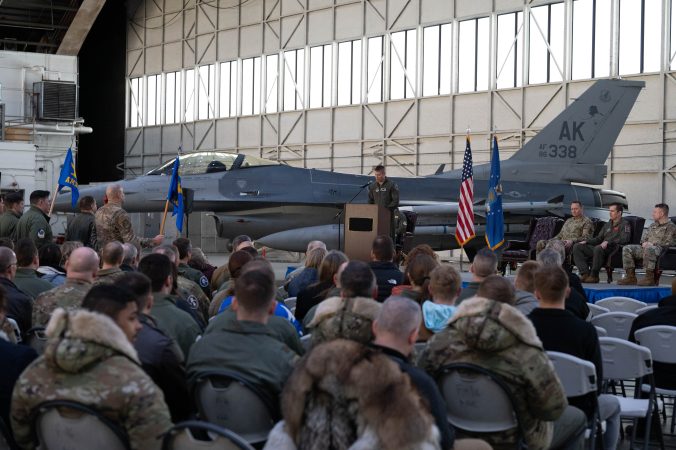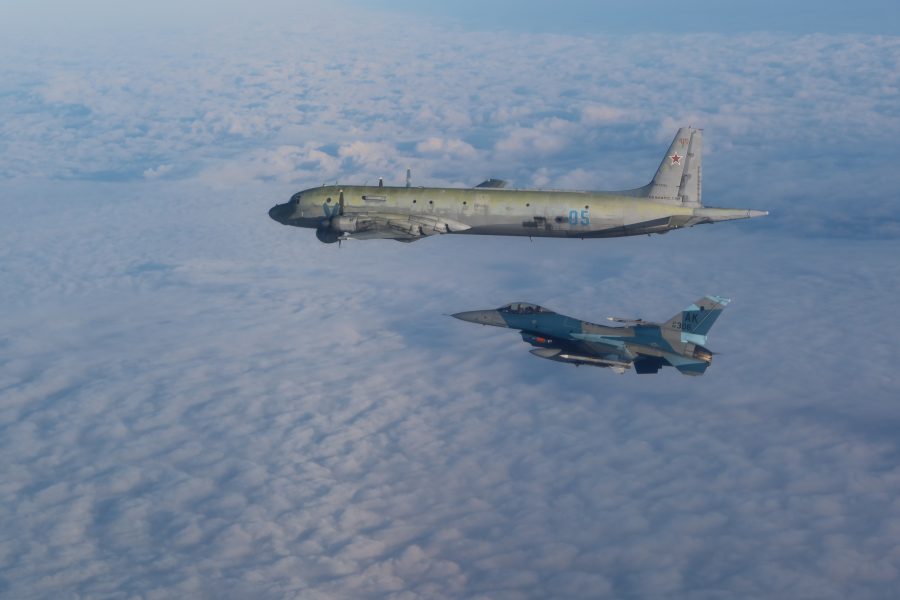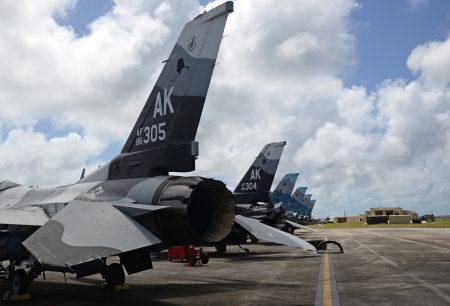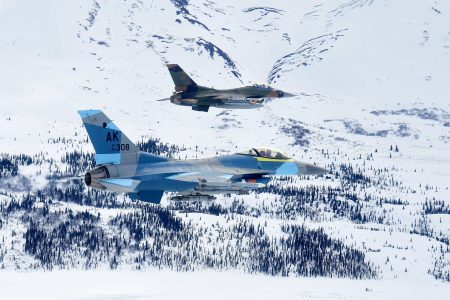When a Russian warplane ventured near Alaska earlier this month, it faced a familiar—if perhaps unexpected—sight.
On a trip into the Alaska Air Identification Zone (ADIZ) in September, a Russian Ilyushin Il-38 maritime surveillance aircraft was photographed by the U.S. military flying alongside a fighter with navy blue, light blue, and gray camouflage, complete with bright red numbering—the colors of the Russian Aerospace Forces, or VKS. But the aircraft was an American F-16 flying a routine intercept mission for NORAD.
How a Russian-styled fighter intercepted a Russian warplane is a story of U.S. Air Force restructuring.
The F-16, from Eielson Air Force Base, Alaska, was from the 18th Fighter Interceptor Squadron, which flies 1980s-era, “pre-block” Vipers. The unit is tasked with homeland defense. But until February, that unit was known as the 18th Aggressor Squadron, tasked with simulating enemy combatants for dissimilar training.
When asked earlier this month about the unit—and specifically whether the bold paint jobs that mimic other nations, a notable feature of Air Force aggressor squadrons, were still on the jets—the commander of U.S. forces in the area noted that the planes still have vestiges of their past.
“They have a variation and a mix of paint jobs, but we’re still on the journey of the development there,” Lt. Gen. Case Cunningham, the commander of the Alaskan NORAD Region, Alaskan Command, and the 11th Air Force, said in an interview with Air & Space Forces Magazine on Sept. 16. “Great Airmen, doing incredible work with the mission that they’ve been given.”
Cunningham is familiar with aggressors, having previously commanded the U.S. Air Force Warfare Center at Nellis Air Force Base, Nev., which runs the Red Flag combat training exercise series complete with a fleet of aggressor aircraft.
The change to the 18th Fighter Interceptor Squadron aligned the unit with “national priorities,” Lt. Gen. David S. Nahom, Cunningham’s predecessor, said earlier this year. The move allowed the unit to “organize, train, and equip for their primary combat mission of providing aerospace control for homeland defense missions,” the 354th Fighter Wing said in an April news release.
“From an 11th Air Force perspective, we’re essentially the force provider to Alaska NORAD region—the alert forces that we have that stand at the ready to run those intercepts,” Cunningham said. “We just stood up the 18th Fighter Interceptor Squadron not that long ago, under Lt. Gen. Nahom’s command, and that kind of bears the brunt of most of that—taking the intercepts there. But we have a much broader alert force that makes that happen so that is definitely a total force team.”

Cunningham pointed out the squadron’s work during an intercept of a combined bomber patrol of Russian and Chinese aircraft in the Alaska ADIZ in July, during which the squadron worked with F-35s, also from the 354th Fighter Wing, and Canadian Royal Air Force F-18 Hornets.
During September, there were four Russian flights into the Alaska ADIZ within the span of a week during a Russian naval exercise, each involving multiple aircraft. Another Russian flight of four aircraft occurred Sept. 23.
The Chinese and Russian flights were all in international airspace as Alaska ADIZ stretches beyond American and Canadian territory, and ADIZ intercepts around the world often occur, including intercepts of American aircraft. The U.S. has intercepted Russian planes near Alaska since the Cold War.
“Even though on the surface, just because you see the pictures, it seems like what happens in Alaska NORAD region is easy,” Cunningham said. “But making that look easy is part of the awesomeness of the team that pulls all that off, because the distance, the geography that exists in the Arctic and across Alaska is significant—underappreciated often. It’s basically like going from the East Coast to the West Coast of the United States and pulling off an intercept.”




